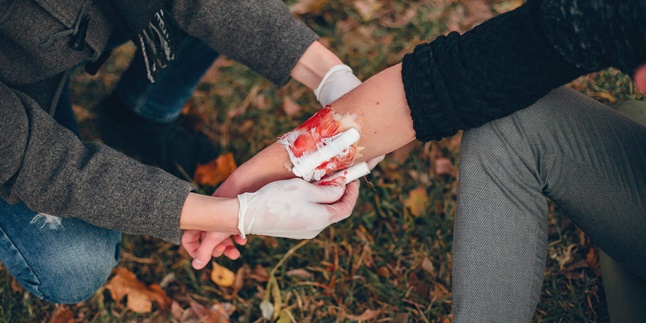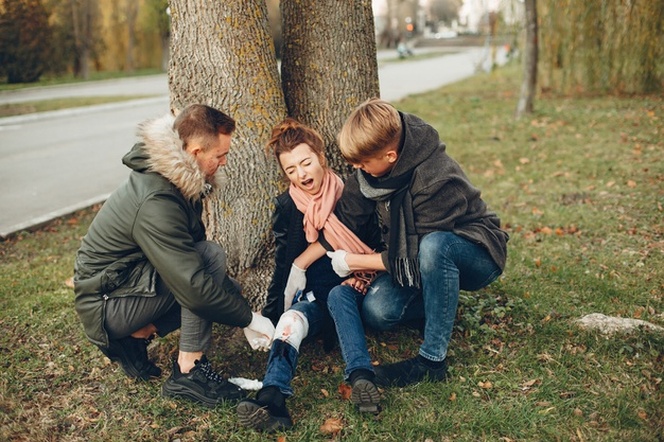Understanding Gotong Royong and Its Values, Important to Know
To better understand the meaning of gotong royong and the importance of preserving this culture, read the following review.

Kapanlagi.com - Until now, almost everyone has experienced wounds. Whether it's from falling, stabbing, scratching, and so on. When experiencing a wound, the most important and primary thing is to handle it properly. However, many people still lack knowledge about the importance of first aid and wound care. This is especially true for large acute wounds. Even though this is useful for preventing and speeding up the wound healing process.
Wounds themselves require moisture to heal. Although wound care has the same basic principles, the steps for caring for them are different. So, before knowing how to care for wounds, it's good to know the types of wounds so that you won't make mistakes when providing first aid. Curious? Let's directly check out the complete review below.

(credit: freepik)
The first type of wound that is often experienced by many people is a scratch wound. This wound is usually caused by friction or scratching on rough or hard surfaces. For example, if your leg is scratched while walking on asphalt. Although it is classified as a mild wound and does not cause much bleeding, you should immediately treat the scratch wound to prevent infection.
The way to treat a scratch wound is by cleaning the wound from dirt first using running water and sterile saline solution. After that, apply antibiotic ointment to keep the wound moist, and avoid exposing the wound to sunlight.
Next, the type of wound that is often experienced by most people is a bruise. This type of wound does not bleed and is usually characterized by a bluish to dark purple color. This can happen because small blood vessels under the skin are damaged due to hitting something or being hit by a blunt object. Although it does not bleed, a bruise can be very painful when pressed.
The first aid for a bruise is to apply an ice pack to the affected area. This can help slow down bleeding and reduce swelling. In addition, you can also elevate the injured body part higher than the chest. This is done to reduce blood flow to the bruised area, thus relieving swelling.

(credit: freepik)
Another type of wound you need to know is a stab wound. Stab wounds are caused by sharp and long objects such as knives, nails, or similar items. This type of wound can even penetrate the skin and reach the inner parts. If not handled properly, a stab wound can result in tetanus. Especially if pierced by a rusty object, seek medical examination immediately.
For less severe stab wounds, you can treat them by immediately soaking the wound in warm water and soap for 15 minutes. Gently rub the wound with another cloth to remove dirt. If there is loose or peeled skin, it is advisable to cut the skin with sterilized scissors to prevent covering the wound. Then, apply antibiotic ointment and a bandage to reduce the risk of infection.
Next, the type of wound and its treatment that you need to know is a torn wound. This wound is still classified as a minor scratch. Usually, this wound occurs when someone has an accident. Basically, the treatment for a torn wound varies depending on the severity of the bleeding.
In some cases, a torn wound requires stitches by a doctor to reattach or close the separated or open body parts. However, in mild cases, you can handle it by closing the wound using a plaster. Before using the plaster, make sure to clean it so that no dirt sticks.

(credit: freepik)
Many people also experience burn wounds. This type of wound occurs due to damage to the skin tissue caused by excessive heat, chemicals, or electric shock. The proper treatment for burn wounds is to compress the area of the wound until the pain subsides.
If the burn wound forms blisters, know that the blisters contain fluid that protects the skin from infection. If the blisters burst, clean the area with water. Then, apply antibiotic ointment. However, if a rash appears, stop using the ointment. If the burn wound is very cold, you can apply lotion to prevent drying. Then, dress the burn wound with sterile gauze bandage.
An infected wound can worsen if not properly treated. That's why you need to take care of the infected wound. If the size is still small, you can compress it with warm water to help it dry quickly. After that, keep the wound dry, apply antiseptic ointment, and avoid forcing out the pus.
A torn wound is a partial tear of the skin and underlying tissue. Usually, this type of wound occurs due to gunshot, explosion, severe accidents, or fights. Blood flow from this type of wound is usually fast and abundant, so immediate medical treatment is necessary. To treat it, you can apply pressure to the injured area using clean cloth or sterile gauze to prevent continuous bleeding.
Those are the types of wounds and how to treat them as first aid. Hopefully, it is helpful.
(kpl/dtm)
Cobain For You Page (FYP) Yang kamu suka ada di sini,
lihat isinya
To better understand the meaning of gotong royong and the importance of preserving this culture, read the following review.
Vomiting blood is a condition in which a person experiences vomiting accompanied by the discharge of blood. The causes of vomiting blood can come from various triggering factors but are closely related to digestive problems.
Here are some latest short speeches on various topics. And here are some examples of those speeches. Let's check them out KLovers.
The purpose of negotiation is to find a middle ground that benefits both conflicting parties. How is the explanation?
Stay at home and enjoy Christmas with these 5 special Christmas movies!
Hepatitis B disease can be classified into two categories, namely chronic and acute. The causes of hepatitis B can come from various triggering factors followed by certain symptoms.
There are also many types of aquascape plants to beautify your aquarium like underwater scenery. Not only do they beautify the aquarium, but aquascape plants also enhance the atmosphere in your home. That's why aquascape plants are highly sought after as decorations and hiding places for fish.
The cause of athlete's foot can occur due to various triggering factors, both weather and daily activities. Generally, athlete's foot can cause itching and red rashes.
Entrepreneurship is one of the types of jobs that are pursued by many, especially young people. Because succeeding at a young age is a motivation in itself to implement various businesses. So what types of entrepreneurship are suitable for young people?
National integration is an important step in realizing national unity. National integration is the process of unifying various social groups. How is it explained?
Here are 60 cool coffee quotes to start your day. What are those quotes? Let's check it out KLovers.
The cause of vaginal itching can occur due to various triggering factors including bacterial or fungal infections. Women need to know about the itchy vagina to prevent further risk levels.